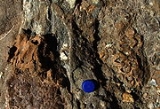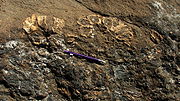
Megabalanus
Encyclopedia
Megabalanus is a genus of barnacle
. It grows to 7 centimetres (2.8 in) in length, and inhabits the lower zone.
shell consisting of five plates. It reaches up to 7 cm (2.8 in) in height .
. The organism
s tend to grow in clusters of around a dozen
individuals. Other species are more select, like M. californicus of tidal habitats in California
and the greater North America
n Pacific coast.
While many barnacles deal with competition for space by organisms such as limpet
s and mussel
s by growing many organisms close together in colonies, Megabalanus responds by rapidly growing to a very large size . Their large size also helps reduce predation - although it makes them large enough to be harvested for human
consumption.
Surprisingly, the specific name tintinnabulum does not refer to the Tintin
character Captain Haddock
, whose catchphrase was "Blistering barnacles"; it was designated by 18th century taxonomist
Linnaeus and refers to the animal's shape — a tintinnabulum is a handbell .
 Fossilised specimens of Megabalanus have been found dating back to the Miocene
Fossilised specimens of Megabalanus have been found dating back to the Miocene
. Fossils bearing a close resemblance to M. tintinnabulum are preserved in large numbers in the Tabernas Basin
of Spain
. A case study of this area showed that the state of preservation of the organisms makes it possible to estimate the distance they were transported post mortem. Since the species today lives in the intertidal zone, this allows an estimate to be made of the distance from the shoreline, and by implication the water depth. These observations are backed up by the appearance of the deep water trace fossil
Zoophycum in the predicted deepest waters, suggesting that barnacles can be a good for water depth.
Barnacle
A barnacle is a type of arthropod belonging to infraclass Cirripedia in the subphylum Crustacea, and is hence related to crabs and lobsters. Barnacles are exclusively marine, and tend to live in shallow and tidal waters, typically in erosive settings. They are sessile suspension feeders, and have...
. It grows to 7 centimetres (2.8 in) in length, and inhabits the lower zone.
Morphology
Megabalanus is an acorn barnacle comprising an organism dwelling in a calcium carbonateCalcium carbonate
Calcium carbonate is a chemical compound with the formula CaCO3. It is a common substance found in rocks in all parts of the world, and is the main component of shells of marine organisms, snails, coal balls, pearls, and eggshells. Calcium carbonate is the active ingredient in agricultural lime,...
shell consisting of five plates. It reaches up to 7 cm (2.8 in) in height .
Ecology
Just like other barnacles, they are suspension feeders, grabbing particulate matter from the water column overhead. M. tintinnabulum has a worldwide distribution and is commonly found on wave-beaten shores, in the lower intertidal zoneIntertidal zone
The intertidal zone is the area that is above water at low tide and under water at high tide . This area can include many different types of habitats, with many types of animals like starfish, sea urchins, and some species of coral...
. The organism
Organism
In biology, an organism is any contiguous living system . In at least some form, all organisms are capable of response to stimuli, reproduction, growth and development, and maintenance of homoeostasis as a stable whole.An organism may either be unicellular or, as in the case of humans, comprise...
s tend to grow in clusters of around a dozen
Dozen
A dozen is a grouping of approximately twelve. The dozen may be one of the earliest primitive groupings, perhaps because there are approximately a dozen cycles of the moon or months in a cycle of the sun or year...
individuals. Other species are more select, like M. californicus of tidal habitats in California
California
California is a state located on the West Coast of the United States. It is by far the most populous U.S. state, and the third-largest by land area...
and the greater North America
North America
North America is a continent wholly within the Northern Hemisphere and almost wholly within the Western Hemisphere. It is also considered a northern subcontinent of the Americas...
n Pacific coast.
While many barnacles deal with competition for space by organisms such as limpet
Limpet
Limpet is a common name for a number of different kinds of saltwater and freshwater snails ; it is applied to those snails that have a simple shell which is more or less conical in shape, and either is not spirally coiled, or appears not to be coiled in the adult snails.The name limpet is most...
s and mussel
Mussel
The common name mussel is used for members of several families of clams or bivalvia mollusca, from saltwater and freshwater habitats. These groups have in common a shell whose outline is elongated and asymmetrical compared with other edible clams, which are often more or less rounded or oval.The...
s by growing many organisms close together in colonies, Megabalanus responds by rapidly growing to a very large size . Their large size also helps reduce predation - although it makes them large enough to be harvested for human
Human
Humans are the only living species in the Homo genus...
consumption.
Etymology
The generic name Megabalanus literally translates as "large barnacle".Surprisingly, the specific name tintinnabulum does not refer to the Tintin
The Adventures of Tintin
The Adventures of Tintin is a series of classic comic books created by Belgian artist , who wrote under the pen name of Hergé...
character Captain Haddock
Captain Haddock
Captain Archibald Haddock is a fictional character in The Adventures of Tintin, the series of classic Belgian comic books written and illustrated by Hergé...
, whose catchphrase was "Blistering barnacles"; it was designated by 18th century taxonomist
Taxonomy
Taxonomy is the science of identifying and naming species, and arranging them into a classification. The field of taxonomy, sometimes referred to as "biological taxonomy", revolves around the description and use of taxonomic units, known as taxa...
Linnaeus and refers to the animal's shape — a tintinnabulum is a handbell .
Geological utility

Miocene
The Miocene is a geological epoch of the Neogene Period and extends from about . The Miocene was named by Sir Charles Lyell. Its name comes from the Greek words and and means "less recent" because it has 18% fewer modern sea invertebrates than the Pliocene. The Miocene follows the Oligocene...
. Fossils bearing a close resemblance to M. tintinnabulum are preserved in large numbers in the Tabernas Basin
Tabernas Desert
The Tabernas Desert is a desert in Spain. It is located in the province of Almería about north of the capital, Almería, in the Tabernas municipality...
of Spain
Spain
Spain , officially the Kingdom of Spain languages]] under the European Charter for Regional or Minority Languages. In each of these, Spain's official name is as follows:;;;;;;), is a country and member state of the European Union located in southwestern Europe on the Iberian Peninsula...
. A case study of this area showed that the state of preservation of the organisms makes it possible to estimate the distance they were transported post mortem. Since the species today lives in the intertidal zone, this allows an estimate to be made of the distance from the shoreline, and by implication the water depth. These observations are backed up by the appearance of the deep water trace fossil
Trace fossil
Trace fossils, also called ichnofossils , are geological records of biological activity. Trace fossils may be impressions made on the substrate by an organism: for example, burrows, borings , urolites , footprints and feeding marks, and root cavities...
Zoophycum in the predicted deepest waters, suggesting that barnacles can be a good for water depth.

